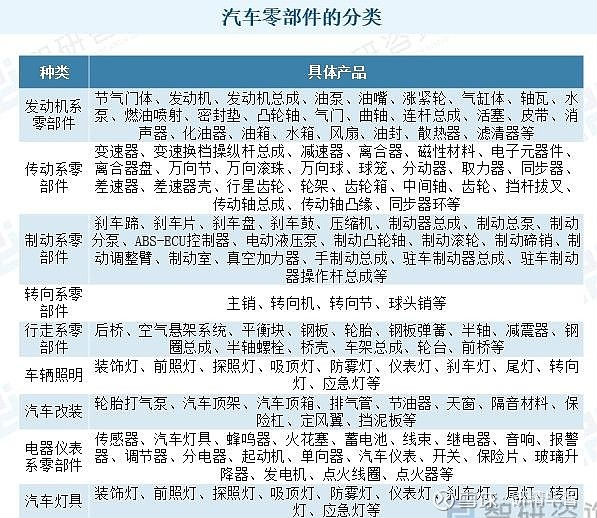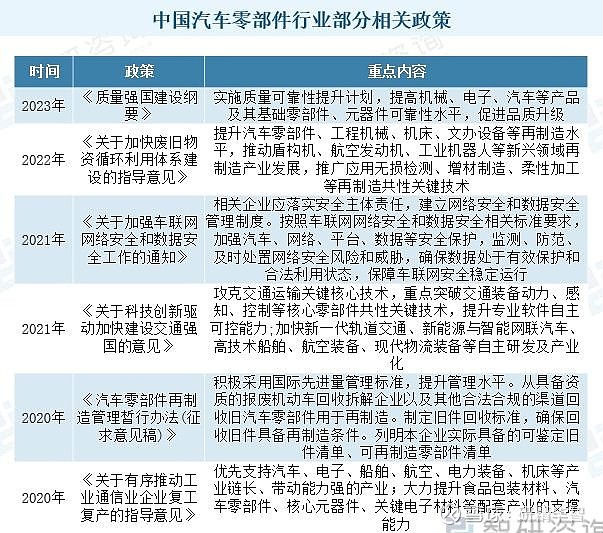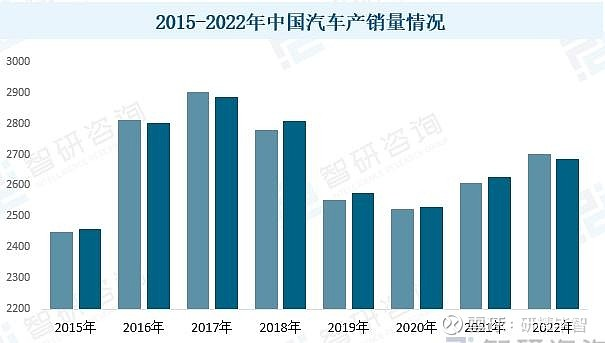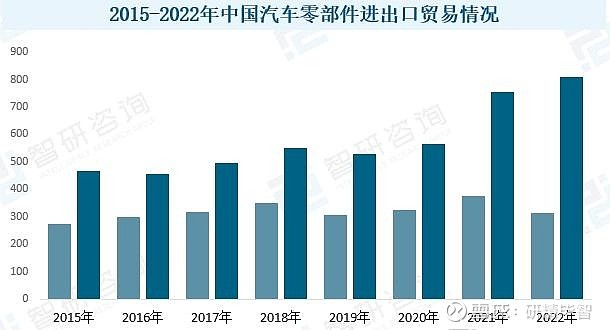Overview: With the rapid development of China's macro economy and the improvement of per capita purchasing power, cars have begun to enter households in large numbers, and the automotive parts industry has ushered in a period of great development, with rapid growth in industry scale. In 2018, due to factors such as the overall decline in the automotive market, the decrease in subsidies for new energy vehicles, and the gradual increase in emission standards, the revenue scale of the automotive parts industry has declined. Subsequently, with the gradual recovery of the automotive consumer market and the rapid growth of new energy vehicle sales, the revenue of the automotive parts industry has steadily rebounded, reaching 4195.3 billion yuan by 2022, a year-on-year increase of 3.2%.
Keywords: Development Trends of the Automotive Parts Industry, Competitive Landscape of the Automotive Parts Industry, Market Size of the Automotive Parts Industry, Import and Export Trade of the Automotive Parts Industry
1、 Overview
Automotive parts are a collective term for the various components and accessories that make up a car, usually referring to all parts and components except for the car frame. The frame can also be considered a component, but it is not the same concept as the parts. Automotive components include the engine, chassis, body, electrical equipment, fuel system, cooling system, transmission system, and control system of a car. These components work together to enable the car to operate normally and meet various performance requirements. They are an important component of automotive manufacturing and have a crucial impact on the performance and quality of the car.

2、 Industry policies
In recent years, national policies have continuously promoted the adjustment and upgrading of the automotive industry, encouraging the research and development of high-quality, high-tech independent brand cars, and maintaining significant support for new energy vehicles, relying on policy dividends to promote the vigorous development of China's new energy vehicle industry. At the same time, with the development of global economic globalization and market integration, the position of automotive parts in the automotive industry has become prominent. Therefore, macro management and policy guidance for the automotive manufacturing industry by government departments and industry associations in China are constantly emerging. There are numerous types and quantities of automotive parts, which involve different industries and fields. There are significant differences in technical standards, production methods, and other aspects. Currently, the national policies related to automotive parts manufacturing are mainly distributed in the automotive industry.

3、 Industrial chain
The upstream of the automotive parts industry supply chain is the raw material supply link, mainly including steel, non-ferrous metals, electronic components, plastics, rubber, wood, glass, ceramics, leather, etc; The midstream automotive parts have a rich variety of styles, among which the engine set and electronic control system belong to the core components of automobiles; The downstream mainly includes automobile manufacturers, automobile 4S stores, automobile repair shops, automobile parts suppliers, automobile modification factories, etc.

Automotive components are the foundation of the development of the automotive industry and an important component of it. According to the degree of specialization, the output value of automotive parts accounts for about 50% -70% of the total output value of the vehicle. Therefore, the sales and ownership of the entire vehicle market determine the market demand for automotive components. From the perspective of automobile production and sales in China, since the reform and opening up, the automobile industry has developed rapidly and has now become the world's largest automobile producer and new car consumer market. According to data, China's automobile production in 2022 was 27.021 million units, a year-on-year increase of 3.6%; The sales volume was 26.864 million units, a year-on-year increase of 2.2%.

4、 Development Status
Automotive components are the foundation of the development of the automotive industry and an important component of it. According to the degree of specialization, the output value of automotive parts accounts for about 50% -70% of the total output value of the vehicle. After 2000, with the rapid development of China's macro economy and the improvement of per capita purchasing power, cars began to enter households in large numbers, and the automotive parts industry ushered in a period of great development, with rapid growth in industry scale. In 2018, due to factors such as the overall decline in the automotive market, the decrease in subsidies for new energy vehicles, and the gradual increase in emission standards, the revenue scale of the automotive parts industry has declined. Subsequently, with the gradual recovery of the automotive consumer market and the rapid growth of new energy vehicle sales, the revenue of the automotive parts industry has steadily rebounded, reaching 4195.3 billion yuan by 2022, a year-on-year increase of 3.2%.

China is a major country in the automotive industry, with sufficient production and supply of automotive grade related components. Therefore, China's automotive components are mainly exported for trade. Before 2021, in recent years, the scale of China's import and export of automotive parts has basically stabilized. In 2021, the global supply of automotive chips rebounded, and the overall demand for automobiles rebounded. In addition, with the outbreak of new energy vehicle production and sales, the overall import and export of automotive parts also showed a significant increase. According to data, the import amount of automotive parts in China in 2022 was 31.297 billion US dollars, a year-on-year decrease of 16.9%; The export amount was 81.089 billion US dollars, a year-on-year increase of 7.3%.

5、 Key enterprises
The company has grown and developed with the localization process of Chinese automotive components, possessing significant first mover advantages and comprehensive advantages in QSTP (quality, service, technology, price). The segmented market share of products such as instrument panels, car seats, headlights, airbags, and bumpers in the interior and exterior parts sector, as well as chassis structural components, transmission shafts, air conditioning compressors, steering gears, and window openers in the functional assembly sector, are among the top in China. In recent years, while maintaining its development advantages in the domestic automotive supporting market, the company has actively promoted the internationalization of its core business and gradually established a global market advantage in related business fields. In addition to maintaining a high market share in the global automotive interior market, its core business segments such as automotive seats and passive safety have secured matching points with key global customers such as Volkswagen, General Motors, Audi, BMW, Mercedes Benz, Tesla, leveraging its global customer relationships and operational capabilities. In addition, some of the company's advantageous businesses and products such as lightweight cast aluminum, fuel tank systems, and automotive electronics have also entered markets in Europe, the United States, South Korea, Australia, and Southeast Asia. According to data, the company's revenue in 2022 reached 149.554 billion yuan, a year-on-year increase of 14.1%, with a gross profit margin of 13.66%.

6、 Development Trends
Electronic and lightweight development. Since its inception, automobiles have mainly relied on mechanical technology applications, but currently the potential for creating added value solely through mechanical technology is relatively limited. The application of electronics and information technology in the automotive industry has opened up new space for creating high added value. With the development of the automotive industry abroad, automotive electronic technology has been widely applied to the control and fault diagnosis of engines, chassis, and body, as well as audio, communication, navigation, and other aspects, greatly improving the safety performance, emission performance, economic performance, and comfort of the entire vehicle. It can be foreseen that in the future, the automotive parts industry will combine more emerging technologies, and the level of electronicization is expected to continue to improve. In addition, lightweighting is one of the important ways for traditional cars to save energy and improve the range of new energy vehicles. The lightweighting of cars is to reduce the curb weight of cars as much as possible while ensuring their strength and safety performance. The lightweighting of future cars is actually the lightweighting of components. The widespread application of aluminum castings, aluminum magnesium alloy parts, and automotive plastic parts will be an important trend.
Integrated and modular development. Under the trend of lightweight and electronic components, the industry will gradually implement product upgrades and shift towards integrated and modular supply. The integration and modularization of automotive parts manufacturing is a technical means of replacing multiple components with a single module component by integrating functions that were previously implemented separately by multiple components into one module component through new designs and processes. The integration and modularization of automotive parts systems have many advantages. Firstly, compared to individual components, integrated and modular components are lighter in weight, which is conducive to the lightweighting of the entire machine and achieves the goal of energy conservation and emission reduction; Secondly, integrated and modular components take up less space, which can optimize the overall spatial layout of the machine and improve its performance; Again, compared to individual components, integrated and modular components reduce installation processes and improve assembly efficiency. The integration and modularization of automotive parts systems have become an important trend in the automotive parts industry, especially in the passenger car automotive parts industry. This will help parts companies enhance their competitive position in the global automotive parts industry and form long-term sustainable development momentum in an increasingly fierce market environment.
Yanjing Bizhi Market Research Network is a comprehensive consulting service platform for professional market research, industry research, enterprise research, and monitoring of industry development status, trends, and prospects. Focus on customized reports such as market research, research reports, industry analysis, qualitative research, market research, industry feasibility studies, special reports, dynamic monitoring, segmented market research, expert interview minutes, etc; Yanjing Bizhi Market Research Network provides professional and objective industry trend analysis, research reports, and market opportunities for users to refer to for decision-making
Author: Original research report
Link: https://xueqiu.com/9023515203/276201018
Source: Snowball
Copyright belongs to the author